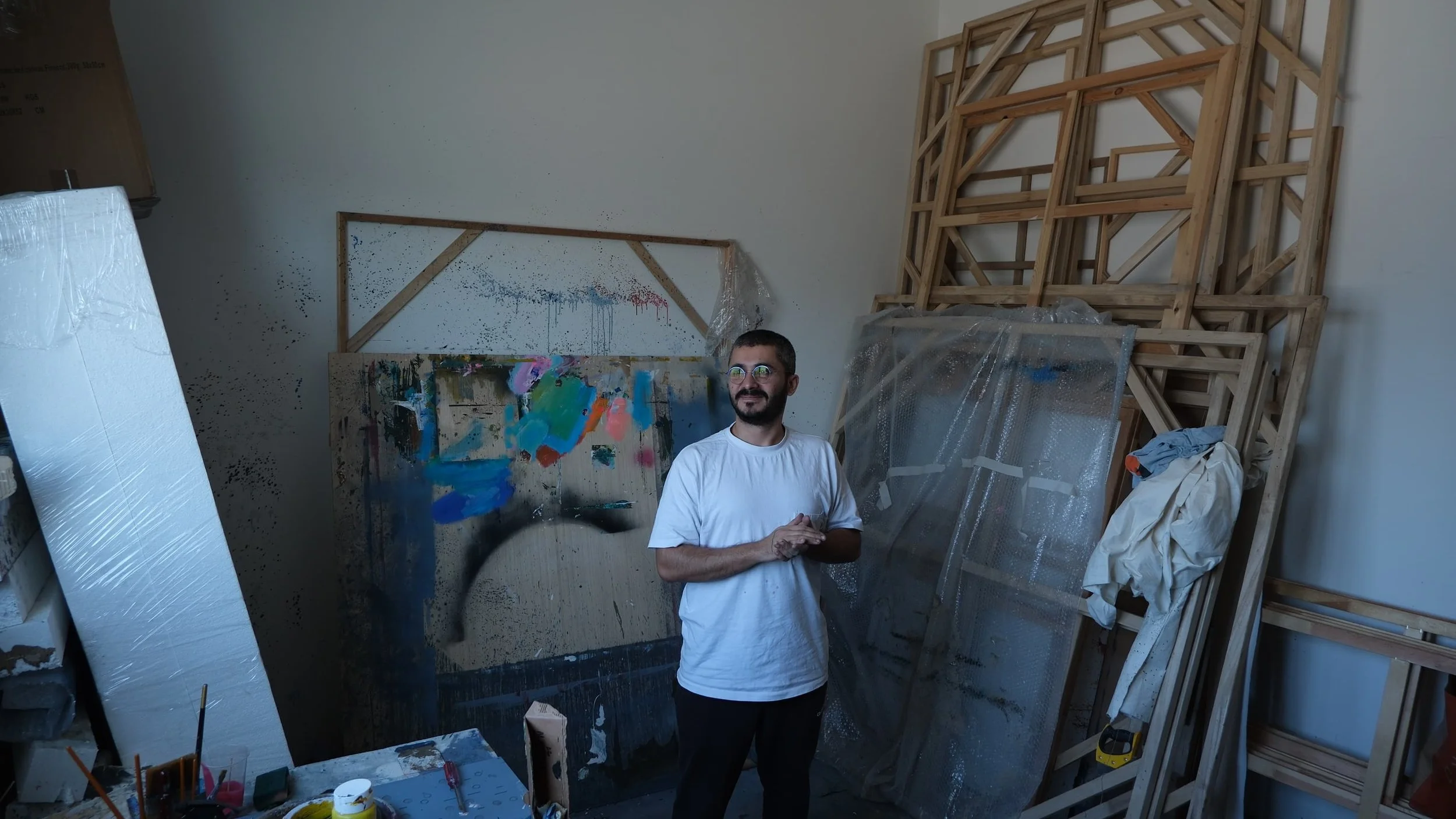Ghaleb Hawila: The Art and Psychology of Reinvention
ALT MENA is as much about showcasing creators reviving the creative legacy of our predecessors as it is about those rethinking it entirely. Ghaleb Hawila is of the latter.
Dubai’s Al Quoz is known for a lot of things: factories, warehouses, trucks, crowds, cafeterias and in more recent gentrified history, quirky cafes, specialty coffee shops, concept stores and art galleries. Among the area’s industrial bustle lies an outlier: Ghaleb’s home-studio, a space that harbors as much artistic genius as it does existential questioning around the human condition.
For Ghaleb, the two come together, like the rakwe[1] he was serving me coffee from and the easy flow of conversation that comes from sipping cup after cup of it. He was always good at physics and biology – so good that his friends never expected the U-turn when he decided to pursue graphic design as a major and even less when he heeded the call of Arabic calligraphy.
Call it a glitch in the system, a hollow gap or an irresistible itch, but Ghaleb found it and had to fix it. In his third year as an undergraduate student at Beirut’s American University of Science and Technology, he went to the dean of his school with a burning question: how is it that we are asked to design brands for regional businesses, yet our design references are almost always from outside the region? A question even more contradicting by the fact that the AUST campus is nestled in the heart of Beirut.
It couldn’t be that regional design references didn’t exist. The first strokes of Arabic calligraphy were drawn in the 7th century in the city of Kufa in Iraq, and its art has been perfected over millenia. It became the guardian of the Qur’an’s sacred words, but also a keeper of knowledge. If astronomers, physicians, mathematicians or cartographers expanded Arab and Muslim knowledge, the calligraphers, and calligraphy, are the reason that that knowledge is undeniably there.
The further Ghaleb went into the 1,400 year history of Arabic calligraphy, the more fascinated he grew by its depth and breadth. Khat is an art of many styles, variations and applications – honed and perfected by calligraphers across the North of Africa, the Levant and the Persian Gulf. There was Kufic, known for its bold, angular strokes and square shapes. Naskh came along as the standard for transcribing the Holy Book and other Islamic texts because of its legibility and practicality. In the 11th century, the Maghribi script was born, renowned for its long flowing curves and extended horizontals. After the Ottomans took over, Diwani emerged as the foremost clerical and legislative script. Thuluth is the most elegant and regal of the classical khats, dating back to the 10th century. The Faarisi[2] style, born in Iran in the 13th century, spread through Central and South Asia, Iraq and the Ottoman Empire, cementing itself as the national script in many of these countries.
Why was all that knowledge being ignored? More importantly, what was Ghaleb going to do about it? Simple: make it his mission to bring khat into the 21st century. What inspired him most was the study of collective art movements - of which Arabic calligraphy – and seeing how patterns of thinking became new ways of doing, how waves of calligraphers built on each other’s work, how collective of a history it was. Ghaleb wants to be part of the collective, his name etched alongside those of his ancestors as a protagonist in the evolution story of this art form.
While a big part of his mission is to (re)connect with ancestral knowledge, a bigger part is to stretch the limitations of Arabic calligraphy by breaking the system through experimentation with color, cropping techniques, transparency and speed.
Graduation day loomed. Ghaleb told himself if he couldn’t make a living in Arabic calligraphy, he would settle for a job as a graphic designer, a path he dreaded. He went by popular Lebanese wisdom,[3] الطيز النقالة مش شغالة, loosely meaning that success comes from being consistent with something.
Ghaleb did just that, starting small with a few sketches for friends here and there, and an Instagram page to show his designs. The game changer came all the way from Miami. An email from someone asking him to design a tattoo of his children’s names. It was the validation he needed to not only pursue his passion, but financially sustain it. Within six months, he had collaborated with Samsung and Mashrou’ Leila, hosted workshops and worked on commissioned artworks – all while still learning about calligraphy. Fast forward to today, Ghaleb’s work has hung proudly on the walls of Abu Dhabi Art, the Sharjah Calligraphy Biennale, the French Institution in Beirut, the Urban Art Biennale in Germany, the Dubai Opera, AlUla Arts Festival in Saudi Arabia and the Cairo Art Fair – to name a few.
Beyond skill, Ghaleb craved meaning. He appreciated Arabic calligraphy for the visual language that it so beautifully and technically is, but there was more to it. To him, the practice of khat is a mirror into the heart, soul and mind. It is the language he uses to make sense of the world, but also the medium through which he best understands himself.
The end goal is healing. Every piece of Ghaleb’s starts with an existential question. One that originates from a personal experience. Answering it is an academic-like praxis of research: a literature review, followed by primary research in the form of conversations with psychologists, sociologists and spiritual leaders. His findings are then translated visually. Arabic calligraphy is how he delivers the message, not the message itself.
Take Contemporary Scars, a solo he exhibited in 2021. The initial question was incepted at the time of the Lebanese revolution in 2017. He looked around the walls of Beirut: bullet holes, faded graffiti, crumbling plaster, deep cracks running like veins through the concrete. Scars. He wondered: if the walls could speak, what would they say? A few years later, Ghaleb found himself with a scar of his own. He also had an exhibition planned in Dubai for the first time. Through this project, he saw an opportunity for two things: to heal through a deeper awareness of his own scars, but also connect a new audience on the most common and human of experiences: pain.
Ghaleb found answers in Rumi’s the wound is the place where the light can enter or Khalil Gibran’s out of suffering have emerged the strongest souls; the most massive characters are seared with scars. Visually, Contemporary Scars was a series of canvases calligraphed into the journey of a scar, starting from opening it to then see its impact on self, from which a spiritual transformation takes place to ultimately arrive at the transition toward the healed self. This work, in its entirety, helped Ghaleb heal.
Ghaleb’s work exists in the in-between: between the sacred and the contemporary, the structured and the experimental, the personal and the universal. His calligraphy bends, breaks and rebuilds itself, just like the stories it tells.
For him, khat is not just a script but a path to reinvention. It carries the weight of centuries, yet speaks in the laguage of today. With every stroke, he asks: how do we honor the past without being bound by it? How do we create something collectively relevant without losing ourselves?
He doesn’t claim to have all the answers. But with ink, curiosity and time, he keeps searching.
—
[1] Long-handled coffee pot
[2] The styles mentioned in this paragraph are the classical Six Scripts. There are many other variations.
[3] Literally translates to "the butt of the wheelbarrow doesn’t work."
It’s a way of saying that something (or someone) is useless or not functioning as it should. The idea comes from the fact that a wheelbarrow’s purpose is to move things forward, but its back (or "butt") just sits there and does nothing.

